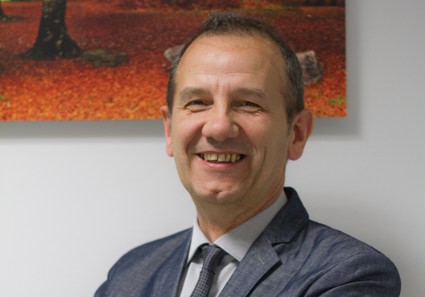User login
SAN DIEGO – Among patients diagnosed with obstructive sleep apnea, compliance with continuous positive airway pressure devices was similar whether they received treatment in a primary care clinic or in a sleep clinic, results from a Spanish study demonstrated.
However, after 6 months of follow-up, patients who received treatment in a sleep clinic had significantly better Epworth Sleepiness Scale (ESS) scores and ratings of satisfaction, compared with those who received treatment in a primary care clinic.
"OSA affects 4%-6% of the adult population, but only 10% of those with severe disease are treated," Dr. Ferran Barbé said at an international conference of the American Thoracic Society. "In all prevalent and chronic disease, all levels of assistance must be implicated."
In a controlled, noninferiority study, Dr. Barbé and his associates randomized 210 patients diagnosed with obstructive sleep apnea to receive management of continuous positive airway pressure (CPAP) compliance in one of two settings: 100 to one of eight primary care clinics in the region of Lleida, Spain, and 110 to the sleep unit at the University of Lleida. The main outcome was CPAP compliance at 6 months of follow-up. Secondary outcomes included change in the EuroQol scale score, patient satisfaction based on a 10-point visual analog scale, and the change in the ESS score.
The mean age of study participants was 56 years, and 80% were men. CPAP compliance was similar between patients in the sleep clinic group and those in the primary care group (a mean of 5.2 vs. 4.9 hr/day, respectively; P = .28), as was the change in EuroQol scale score (a mean change of 0.17; P = .49). However, patients in the sleep clinic group reported significantly higher rates of satisfaction, compared with their counterparts in the primary care group (a score of 9 vs. 7.5; P less than .001). They also demonstrated significantly greater changes in ESS score (–6.07 vs. –4.09; P = .04).
Overall treatment costs were less expensive in the primary care group, compared with the sleep clinic group.
Primary care physicians "need to reinforce actions that improve self-reported well-being in OSA patients," Dr. Barbé concluded.
The study was supported by the Instituto de Salud Carlos III, the Spanish Society of Pulmonology and Thoracic Surgery, Societat Catalana de Pneumologia, and ALLER (Respiratory Association of Lleida). Dr. Barbé said he had no relevant financial conflicts to disclose.
SAN DIEGO – Among patients diagnosed with obstructive sleep apnea, compliance with continuous positive airway pressure devices was similar whether they received treatment in a primary care clinic or in a sleep clinic, results from a Spanish study demonstrated.
However, after 6 months of follow-up, patients who received treatment in a sleep clinic had significantly better Epworth Sleepiness Scale (ESS) scores and ratings of satisfaction, compared with those who received treatment in a primary care clinic.
"OSA affects 4%-6% of the adult population, but only 10% of those with severe disease are treated," Dr. Ferran Barbé said at an international conference of the American Thoracic Society. "In all prevalent and chronic disease, all levels of assistance must be implicated."
In a controlled, noninferiority study, Dr. Barbé and his associates randomized 210 patients diagnosed with obstructive sleep apnea to receive management of continuous positive airway pressure (CPAP) compliance in one of two settings: 100 to one of eight primary care clinics in the region of Lleida, Spain, and 110 to the sleep unit at the University of Lleida. The main outcome was CPAP compliance at 6 months of follow-up. Secondary outcomes included change in the EuroQol scale score, patient satisfaction based on a 10-point visual analog scale, and the change in the ESS score.
The mean age of study participants was 56 years, and 80% were men. CPAP compliance was similar between patients in the sleep clinic group and those in the primary care group (a mean of 5.2 vs. 4.9 hr/day, respectively; P = .28), as was the change in EuroQol scale score (a mean change of 0.17; P = .49). However, patients in the sleep clinic group reported significantly higher rates of satisfaction, compared with their counterparts in the primary care group (a score of 9 vs. 7.5; P less than .001). They also demonstrated significantly greater changes in ESS score (–6.07 vs. –4.09; P = .04).
Overall treatment costs were less expensive in the primary care group, compared with the sleep clinic group.
Primary care physicians "need to reinforce actions that improve self-reported well-being in OSA patients," Dr. Barbé concluded.
The study was supported by the Instituto de Salud Carlos III, the Spanish Society of Pulmonology and Thoracic Surgery, Societat Catalana de Pneumologia, and ALLER (Respiratory Association of Lleida). Dr. Barbé said he had no relevant financial conflicts to disclose.
SAN DIEGO – Among patients diagnosed with obstructive sleep apnea, compliance with continuous positive airway pressure devices was similar whether they received treatment in a primary care clinic or in a sleep clinic, results from a Spanish study demonstrated.
However, after 6 months of follow-up, patients who received treatment in a sleep clinic had significantly better Epworth Sleepiness Scale (ESS) scores and ratings of satisfaction, compared with those who received treatment in a primary care clinic.
"OSA affects 4%-6% of the adult population, but only 10% of those with severe disease are treated," Dr. Ferran Barbé said at an international conference of the American Thoracic Society. "In all prevalent and chronic disease, all levels of assistance must be implicated."
In a controlled, noninferiority study, Dr. Barbé and his associates randomized 210 patients diagnosed with obstructive sleep apnea to receive management of continuous positive airway pressure (CPAP) compliance in one of two settings: 100 to one of eight primary care clinics in the region of Lleida, Spain, and 110 to the sleep unit at the University of Lleida. The main outcome was CPAP compliance at 6 months of follow-up. Secondary outcomes included change in the EuroQol scale score, patient satisfaction based on a 10-point visual analog scale, and the change in the ESS score.
The mean age of study participants was 56 years, and 80% were men. CPAP compliance was similar between patients in the sleep clinic group and those in the primary care group (a mean of 5.2 vs. 4.9 hr/day, respectively; P = .28), as was the change in EuroQol scale score (a mean change of 0.17; P = .49). However, patients in the sleep clinic group reported significantly higher rates of satisfaction, compared with their counterparts in the primary care group (a score of 9 vs. 7.5; P less than .001). They also demonstrated significantly greater changes in ESS score (–6.07 vs. –4.09; P = .04).
Overall treatment costs were less expensive in the primary care group, compared with the sleep clinic group.
Primary care physicians "need to reinforce actions that improve self-reported well-being in OSA patients," Dr. Barbé concluded.
The study was supported by the Instituto de Salud Carlos III, the Spanish Society of Pulmonology and Thoracic Surgery, Societat Catalana de Pneumologia, and ALLER (Respiratory Association of Lleida). Dr. Barbé said he had no relevant financial conflicts to disclose.
AT ATS 2014
Key clinical point: Among patients with obstructive sleep apnea, compliance with CPAP devices in a primary care clinic setting was similar to that in a sleep clinic setting.
Major finding: CPAP compliance was similar between patients in the sleep clinic group and those in the primary care group (a mean of 5.2 vs. 4.9 hr/day, respectively; P = .28), as was the change in EuroQol scale scores (a mean change of 0.17; P = .49).
Data source: A controlled, noninferiority study of 210 patients diagnosed with obstructive sleep apnea who were randomized to receive management of CPAP compliance in one of two settings: 100 to one of eight primary care clinics in the region of Lleida, Spain, and 110 to the sleep unit at the University of Lleida.
Disclosures: The study was supported by the Instituto de Salud Carlos III, the Spanish Society of Pulmonology and Thoracic Surgery, and the Societat Catalana de Pneumologia. Dr. Barbé said that he had no relevant financial conflicts to disclose.

